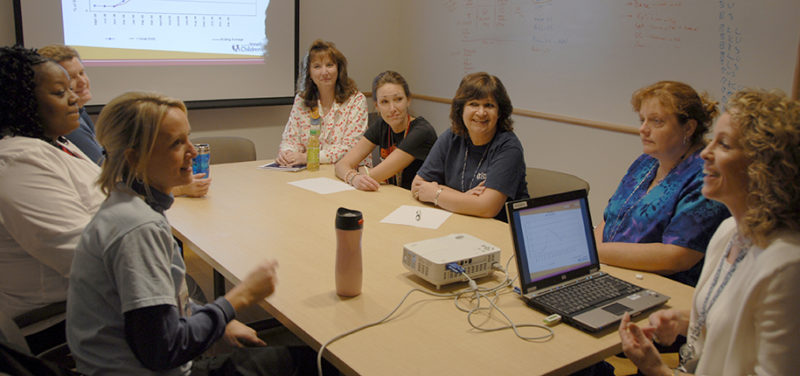
Part of my job in Radiology is to provide clinical education for technologists. Technologists (techs) are certified and trained in imaging patients with various modalities such as x-ray, CT, MRI and ultrasound. It may seem like capturing pictures is all they do, but in actual daily practice their job involves so much more. Like with all hospital positions, the heart of their job is taking care of patients, and that’s where clinical education comes in to play. Technologists at Cincinnati Children’s are required to have a variety of patient care skills. In orientation, they get their initial training in these basic skills. As they advance throughout their careers, they typically receive additional training and learn more complex and integrated skills.
You might be wondering what types of skills I’m referring to. I’ll give you a few examples: For a new technologist within the Radiography Department (they perform x-rays and fluoroscopy) the focus is on recognizing and reporting potential clinical situations. Radiography Technologists (RTs) might have a patient with an intravenous (IV) line and need to be able to recognize if there is a problem or issue with the line. If a problem would occur, they would report it to the nurse caring for the patient. Although the techs do not directly utilize the IV, they are still educated on what to watch out for.
As the technologists in Radiography become more experienced, they might learn more advanced skills. For example, there are certain exams in Radiography that require a urinary catheter. The technologist would learn the fundamentals of this skill set and be trained to place the urinary catheter when working solo.
These additionally taught skills will change from modality to modality. For a new technologist in CT, the focus is going to be a little different than x-ray. In CT the technologist is often required to give intravenous contrast (a medication given through an IV line into the bloodstream, which appears on the images). Because of this, new technologists in CT must learn to start IV lines as part of their orientation. As with all medications, there is a risk for an allergic reaction. The CT technologists must also learn the signs and symptoms of an allergic reaction and what to do if their patient exhibits these symptoms. As our CT technologists become more experienced, they might take on the role of Resource Technologist, which will allow them to actually be the one to train new technologists in these clinical skills.
In addition to departmental requirements to accomplish these education goals, Cincinnati Children’s and the Division of Radiology have their own regulatory requirements for clinical education. There are certain topics that are required education for all technologists in Radiology, while other mandatory topics are modality specific.
We have a variety of methods for delivering the mentioned education and training. Much of the content is delivered through our Electronic Learning Management system (ELM). Another tool we use is Elsevier Mosby’s, which provides online delivery of clinical skill education. Some content is delivered by live presentations or in-person demonstrations. We also video record these presentations so those who cannot attend can watch the presentation at a later time. Technologists can watch a demonstration of the skill and practice on a fake mannequin arm before trying it themselves. Many of these skills require a hands-on component, so we have several mannequins for this purpose. The technologists can safely practice these various skills on an artificial arm in a low-stress environment.
Once our imaging staff has gained enough experience, the technologists can take on the role of Competent Resource. These technologists guide and supervise the hands-on training. Many skills require a yearly review and re-certification. This ensures the most up-to-date procedure is being followed.
Ultimately, the job and education of our technologists are much more complex than one might initially think. Clinical skills education is just one part of what is required to be a Cincinnati Children’s Radiology employee. Mastery of these skills is vital to providing safe and quality care to all of our patients.
Contributed by Julie Dickerson (RN BSN MST) and edited by Tony Dandino, (RT-MR).
 15
15